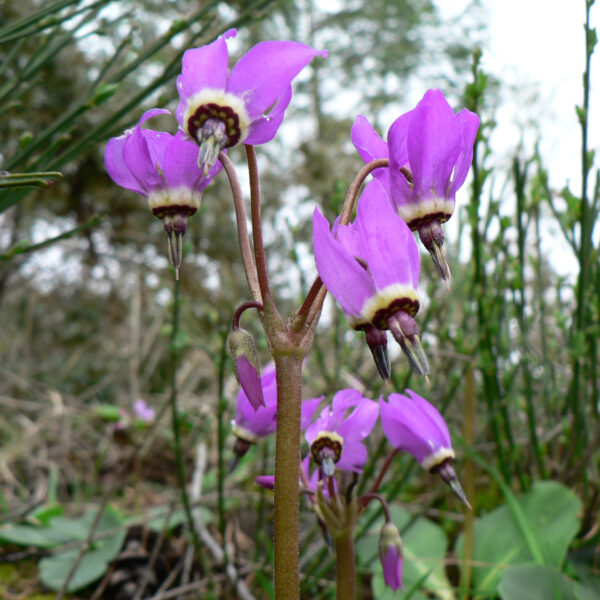Broad-leaved Shootingstar
Dodecatheon hendersonii A. Gray ssp. hendersonii

overview
Perennial herb from slender, fibrous roots and many rice-like bulblets (at flowering time); stems erect, solitary, simple, smooth to glandular short-hairy, 10-30 cm tall. Leaves: Basal leaves, egg-shaped to triangular, usually smooth sometimes glandular-hairy, 3-14 cm long, the blades less than 2-3 times as long as wide, entire to shallowly wavy-margined or remotely toothed, narrowing abruptly to winged stalks 1/4 as long to nearly as long as the blades; stem leaves lacking. Flowers: Inflorescence at terminal, involucrate umbel of 2-15 stalked flowers, the stalks smooth to glandular-short-hairy, floral parts in fours or fives (on the same plant), corollas deeply lobed, the lobes deep magenta to lighter in colour, grading to yellow at the bases and on the tubes, 15-25 mm long, bases of the tubes deep purple-red; calyces lobed, the lobes lanceolate, 6-8 mm long, usually sparsely glandular-short hairy, finely purple-flecked; filaments united to form tubes, 2-4 mm long, deep purple-red, usually cross-wrinkled, sometimes nearly smooth; anthers 4-6 mm long, deep red to purple; connective tissue more deeply coloured, usually cross-wrinkled; stigmas not noticeably enlarged, less than twice as wide as the styles; corollas and stamens deciduous as capsules mature. Fruits: Fruit capsules, cylindrical, 7-12 mm long, the tips coming off like lids (from Douglas et al., 1999). Photo by Dave Polster.
other names
Henderson’s shootingstar
family
Primulaceae
ecological setting
Mesic to dry wood and grassy meadows in the lowland and montane zones (Douglas et al., 1999); Moist, often saline meadows, wet coastal rocks and bluffs, stream banks (Pojar and Mackinnon, 1994); Sporadic in open-canopy forests on water-shedding sites, or in meadow-like communities where early spring moisture is followed by mid-summer drought. Occasionally inhabits water-receiving sites (vernal springs) (Klinka et al., 1989).
nutrients
Nitrogen-rich soils (Klinka et al., 1989).
moisture regime
Dry to moderately moist soils (Klinka et al., 1989).
shade tolerance
Shade tolerant/intolerant (Klinka et al., 1989).
landscaping
Use in rockeries or meadow communities, can also be planted in lawns or used in containers (B. Costanzo, personal communication).
first nations
Not known. Leaves and roots reported as edible in other regions. (Moerman 1988)
flowering time
April - June
fruit ripening time
June - July
seed collection time
July - August
crop intervals
Annual
fruit seed dormancy treatment
Sow ripe seed in fall, covered with thin sand layer, and leave outside for natural cold/moist stratification. Germination should occur in spring. Keep moist as long as leaves are green to speed maturity (Pettinger 2002)
vegetative propagation
| Method | Success Rate | Time of Collection |
|---|---|---|
| Softwood cuttings | n/a | n/a |
| Semi-hardwood cuttings | n/a | n/a |
| Hardwood cuttings | n/a | n/a |
| Root cuttings | n/a | n/a |
| Suckers | n/a | n/a |
| Plant division | good | fall or early spring |
additional info and photos
For more information and pictures, visit the E-Flora BC website at www.eflora.bc.ca.